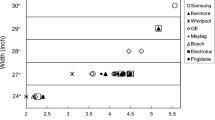Abstract
Planning product platform by taking full advantage of existing product resources is an effective tactic for mass customization, which can help not only keep market share, improve production batch, but also enhance customization. In this paper, we investigate a methodology for achieving the goal. As a basis, product platform is defined as a set of modules, platform parameters and individual parameters. Then, the steps of product platform planning are given. First, product modules are identified; second, a strategy of choosing platform parameters is investigated based on considering the influence of customizing individual parameters upon the activities, such as design, die, machining, assembly, service and management, in all product life cycle; third, an optimization model is employed to determine the value of platform parameters whose carriers are the modules. Finally, the proposed methodology is effectively demonstrated in an instance of motorcycle-hydraulic-disk brake platform planning.










Similar content being viewed by others
References
Adnerson DM, Pine BS II (1997) Agile product development for mass customization. Irwin Publishers, Chicago
Dahmus JB, Gonzalez-zugasti JP, Otto KN (2001) Modular product architecture. Des Stud 22:409–424. doi:10.1016/S0142-694X(01)00004-7
Dobrescu G, Reich Y (2003) Progressive sharing of modules among product variants. Comput Aided Des 35(9):791–806. doi:10.1016/S0010-4485(02)00104-5
Gonzalez-Zugasti JP, Otto KN, Baker JD (2000) A method for architecting product platforms. Res Eng Des 12:61–72. doi:10.1007/s001630050024
Gu P, Sosale S (1999) Product modularization for life cycle engineering. Robot Comput Integr Manuf 15:387–401. doi:10.1016/S0736-5845(99)00049-6
Hofer AP, Gruenenfelder M (2001) Product family management based on platform concepts. International conference on engineering design, ICED 01, Glasgow, 21–23 August 2001
Hölttä KMM, Otto KN (2005) Incorporating design effort complexity measures in product architectural design and assessment. Des Stud 26:463–485. doi:10.1016/j.destud.2004.10.001
Huang GQ, Li L, Chen X (2007) A tandem evolutionary algorithm for platform product customization. J Comput Inf Sci Eng 7(2):151–159. doi:10.1115/1.2720883
Jiao JX, Tseng MM (2004) Customizability analysis in design for mass customization. Comput Aided Des 36:745–757. doi:10.1016/j.cad.2003.09.012
Lee KH (2005) First course on fuzzy theory and applications. Springer, Berlin
Li L, Huang GQ, Newman ST (2007) Interweaving genetic programming and genetic algorithm for structural and parametric optimization in adaptive platform product customization. Robot Comput Integr Manuf 23:650–658. doi:10.1016/j.rcim.2007.02.014
Liu SF (1997) The role and position of grey system theory in science development. J Grey Syst 9(4):351–356
Liu F, Jiang P, Zhang RH, Tan RH (2005) Platform design of function similar products based on bottom-up method. Comput Integr Manuf Syst 11(7):947–952, 985
McAdams DA, Stone RB, Wood KL (1999) Functional interdependence and product similarity based on customer needs. Res Eng Des 11:1–19. doi:10.1007/s001630050001
Messac A, Martinez MP, Simpson TW (2002) Effective product family design using physical programming. Eng Optim 34:245–261. doi:10.1080/03052150211746
Meyer M, Lehnerd A (1997) The power of product platforms. Free Press, New York
Nayak RU, Chen W, Simpson TW (2002) A variation-based method for product family design. Eng Optim 34(1):65–81. doi:10.1080/03052150210910
Pan SX, Gao F, Feng PE (2003) Module partition method research under the circumstances about mass customization. Chin J Mech Eng 39(7):1–6
Qin HB, Zhong YF, Xiao RX, Zhang WG (2005) Product platform communization: platform construction and platform elements capture. Int J Adv Manuf Technol 25:1071–1077. doi:10.1007/s00170-003-1965-7
Rachel C, Andrew BW (1998) Requirements capture: theory and practice. Technovation 18(8/9):497–511
Robertson D, Ulrich K (1998) Planning for product platforms. Sloan Manage Rev 39(4):19–31
Ronald SF, Simpson TW (2003) Product platform design to improve commonality in custom products. J Intell Manuf 14:541–556. doi:10.1023/A:1027306704980
Shooter SB, Simpson TW, Kumara SRT, Stone RB (2005) Toward a multi-agent information management infrastructure for product family planning and mass customization. Int J Mass Cust 1(1):134–155
Silveira DG, Borenstein D, Fogliatoo FS (2001) Mass customization: literature review and research directions. Int J Prod Econ 72(1):1–13. doi:10.1016/S0925-5273(00)00079-7
Simpson TW, D’Souza BS (2004) Assessing variable levels of platform commonality within a product family using a multi-objective genetic algorithm. Concurrent Eng Res Appl 12(2):119–129
Simpson TW, Chen W, Allen JK, Mistree F (1996) Conceptual design of a family of products through the use of the robust concept exploration method. 6th AIAA/USAF/NASA/JSSMO Symposium on Multidisciplinary Analysis and Optimization, Bellevue, AIAA 2:1535–1545
Simpson TW, Jonathan RAM, Mistree F (2001) Product platform design: method and application. Res Eng Des 13:2–22. doi:10.1007/s001630100002
Stone RB, Wood KL, Crawford RH (2000a) A heuristic method for identifying modules for product architectures. Des Stud 21:5–31. doi:10.1016/S0142-694X(99)00003-4
Stone RB, Wood KL, Crawford RH (2000b) Using quantitative functional models to develop product architectures. Des Stud 21(3):239–260
Tseng MM, Du XH (1998) Design by customers for mass customization products. Ann CIRP 47(1):103–106. doi:10.1016/S0007-8506(07)62795-4
Ulrich K (1995) The role of product architecture in the manufacturing firm. Res Policy 24:419–440. doi:10.1016/0048-7333(94)00775-3
Yang TG, Beiter KA, Ishii K (2005) Product platform development: considering product maturity and morphology. In: ASME International Mechanical Engineering Congress and Exposition, 5–11 November 2005, Orlando, FL, USA
Zhu B, Jiang PY, Long YL (2003) Product platform variables planning method based on regression analysis and its web implementation. Comput Integr Manuf Syst 9(12):1067–1071
Acknowledgments
This work is being supported by the National Natural Science Foundation of CHINA under Grant No. 50705087, the Zhejiang Provincial Natural Science Foundation of CHINA under Grant No. Y105200 and Zhejiang Provincial Science and Technology Planning Key Project of CHINA under Grant No. 2006C21003.
Author information
Authors and Affiliations
Corresponding author
Rights and permissions
About this article
Cite this article
Gao, F., Xiao, G. & Simpson, T.W. Module-scale-based product platform planning. Res Eng Design 20, 129–141 (2009). https://doi.org/10.1007/s00163-008-0061-2
Received:
Accepted:
Published:
Issue Date:
DOI: https://doi.org/10.1007/s00163-008-0061-2




